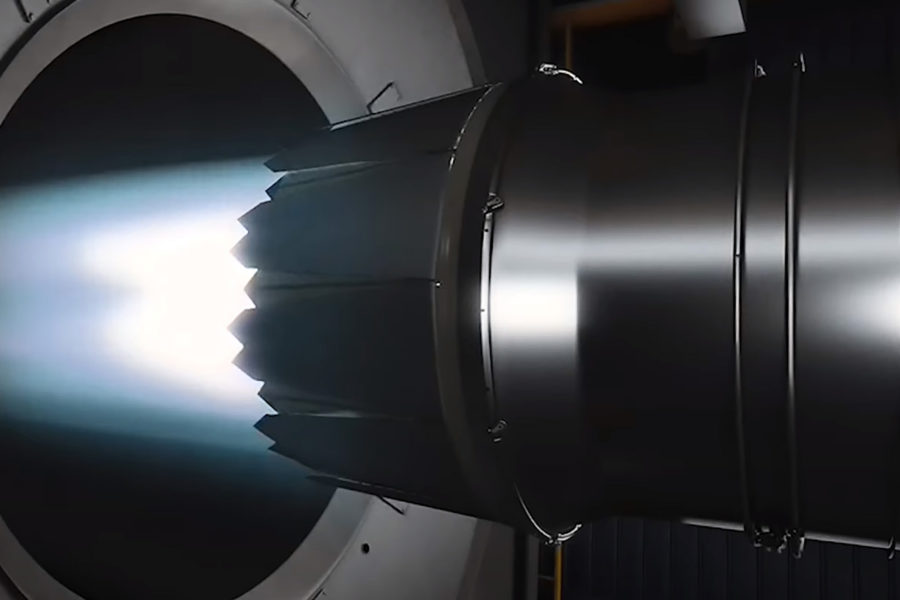The Air Force will likely make a decision this summer on whether to insert Advanced Engine Transition Program (AETP) powerplants into the F-35 fleet, Secretary Frank Kendall said, because he doesn’t want to waste money on further delay if the program isn’t going forward.
“We need a decision, which is where I am right now,” Kendall told the Potomac Officers Club in Tysons, Va.
“I don’t want to limp along, spending R&D money on a program we either can’t afford or that we’re just not going to get agreement on among the different services,” he said. The fiscal 2024 budget is already being debated in the Pentagon, and Kendall said he hopes the AETP decision will be counted in it. For fiscal 2023, research and development continues in the engine, he noted.
Congress added language to the fiscal 2022 National Defense Authorization Act directing the services to look hard at incorporating either the GE XA-100 or Pratt & Whitney XA-101 engine into the F-35 as early as 2027. The AETP was intended to power the crewed sixth-generation fighter at the heart of the Next Generation Air Dominance (NGAD) system, but Congress wants the engine to power Block 4 and later F-35s as well.
However, there are “two obstacles” to getting the AETP into the F-35, he said.
“One is the high cost. It’s going to take several billion dollars and a five-year program to move through [engineering and manufacturing development] to get that program ready to be fielded.”
The other, he said, is that the AETP “will not fit all three variants of the F-35.” Specifically, the AETP’s new third-stream airflow makes it incompatible with the F-35B, which uses redirected air and a downward-rotating rear exhaust to be capable of vertical takeoffs and landings.
Former F-35 Joint Program Office director Lt. Gen. Eric T. Fick has said that if the Air Force wishes to pursue the AETP for its own F-35As, it will have to do so at its own expense, because the F-35 program is structured such that “you have to pay to be different” from the other users, to hold costs down for all.
In addition, “there’s other things on the table; there are upgrades to the current F135” that Pratt & Whitney is proposing, Kendall said.
“I am hopeful that we will have” an AETP decision in the fiscal 2024 budget, Kendall said. “I think we need to make some decision about the future of the F-35’s engine and get on with it.”
Kendall said he, personally, “very much desire[s]” to have “the AETP solution” in the F-35 because “you get significant range extension out of that” as well as “more capability that we need” for the F-35. He didn’t specify the added capabilities, but industry officials have said some would entail additional electrical power for F-35 electronic warfare and directed-energy systems as well as additional thrust and some improvement in stealth.
Kendall said the decision may rest with William A. LaPlante, the current incumbent in Kendall’s old job, that of Pentagon undersecretary for acquisition and sustainment, who will “help us sort it all out” among the services with a unified “Department of Defense position.”
But Kendall noted that the Air Force “would have a very hard time affording the AETP if it’s only going in the F-35A” variant of the Joint Strike Fighter. He has previously said he has been in talks with the Secretary of the Navy about that service adopting the AETP for its carrier-capable F-35Cs. Industry officials have also not ruled out the potential for the AETP to be used in the Marine Corps F-35B, but acknowledged it would take substantially more modification of both the engine and the aircraft than the standard AETP.
Some 35 members of Congress, anxious to keep the F135 in the F-35, sent LaPlante a letter July 22 urging him to drop the idea of putting the AETP in the F-35. Putting the AETP in the F-35 would be too risky, they said, and it is already “the most complex and expensive program” in the Pentagon’s portfolio. Now that the F-35 is transitioning to high-rate production and sustainment, a new engine would needlessly complicate matters, they said. The letter stressed that the “cornerstone” of the F-35 program is that all users rely on a common logistics base; and that introducing a dissimilar engine would add cost and expand the count of parts needed to keep on hand.
“Now is not the time” to introduce a new variable into the F-35’s struggle to reach affordable sustainment costs, the lawmakers said, also noting Kendall’s own testimony earlier this year that the AETP is likely to be a $6 billion development program to reach operational status.

